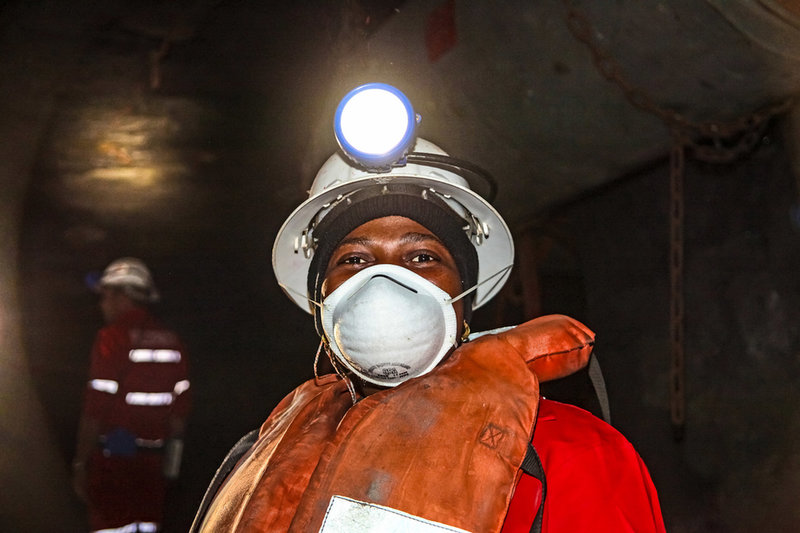The big interview
Women in mining: how has the industry progressed in the last decade?
The mining industry has a reputation for being an unsafe space for women – but how much progress is being made? Kit Million Ross examines a new report documenting ten years of industry changes.

In a platinum/palladium mine in Johannesburg, South Africa. Credit: Sunshine Seeds via Shutterstock
When you imagine a mining worker, what do you picture? Perhaps a grizzled white man in a helmet and high-vis, or a group of men in suits sat around a table? For many, mining is seen as a male-dominated industry, often hostile to women. This has led to efforts to recruit more women into mining, but how much impact have they had? Law firm White & Case attempted to answer this with their new report “Changing the face of mining”, a review of women on boards and in C-Suite positions in the mining industry over the past ten years. The research, developed in partnership with ARCH Emerging Markets Partners and Women in Mining UK, shows some progress, but arguably not enough. According to the report “at the current rate of change, it will take the top 100 listed mining companies until 2026 to reach a 30% critical mass [of women on boards and executive-level positions, which research shows correlates with better], and until 2030 for the top 500 listed mining companies to do the same”.
Here, Rebecca Campbell, head of the Global Mining & Metals Industry Group at White & Case, and Amanda van Dyke, managing director of the ARCH Sustainable Resources Strategy, discuss the report and what it reveals about gender diversity in the mining industry.

Amanda van Dyke. Credit: White & Case/Arch

Rebecca Campbell. Credit: White & Case/Arch
Kit-Million Ross: What is the purpose of this research report?
Campbell and van Dyke: This 2023 research report and the one undertaken ten years ago are written by women in mining for the whole sector, to shine a light on the value of diversity and inspire other historically under-represented groups to make further progress on diversity and inclusion. There is an old expression ‘what gets measured gets done’. The main aim of the report is to make a factually-supported business case for women in mining. Increasing women's participation on corporate boards is not just the right thing to do, it's good for business, and the evidence is compelling. The 2023 research found that there remains a positive correlation between a higher earnings margin, a higher return on capital invested and higher ESG scores, with an increased percentage of women on boards.
Kit Million Ross: Has the rate of progress for women in mining in the past decade been better or worse than you expected?
Campbell and van Dyke: Albeit starting from a low base, top mining companies have made credible progress over the decade. The top 500 listed mining companies have increased the number of women on boards by 13%, from 4.9% in 2012 to 17.6% in 2022. For the top 100 listed miners, the rate of increase was 15% over the period, from 7.9% in 2012 to 22.6% in 2022. While these figures constitute significant progress, the low average upon which they are based is a disheartening reminder of just how much still needs to be done to increase female participation in the mining industry. Women taking on senior leadership roles in the industry is still relatively uncommon, and the mining industry mining continues to lag behind other key industries with one of the lowest female board participation rates in the world.
Kit Million Ross: Did anything that came out in the report surprise you?
Campbell and van Dyke: The progress in women holding chairperson positions in the top 100 mining companies is particularly encouraging, with 11 women in such roles by 2022, compared to only one in 2012. However, the majority of female appointments remain in non-executive director (NED) positions, which has been a consistent trend since 2012. Currently, 93.1% of female directors in the top 100 companies are NEDs, while male directors in the same category account for 77.4%. Similarly, in the top 500 companies, 91.1% of female directors are NEDs, compared to 75% of male directors.
Kit Million Ross: In your opinion, what are the biggest hurdles for women in the industry? How can they be addressed?
Campbell and van Dyke: Women face myriad challenges going into the mining industry, including bias, discrimination, and a lack of representation in leadership positions or opportunities. While the report found that female recruitment at junior levels is reasonably high, the issue is retaining and advancing those women into positions of leadership.
The traditional recruitment base of the sector for C-suite positions— among engineers and geologists—is male-dominated, which restricts the talent pool when recruiting at that level. To overcome these barriers, cultural changes must start at the top with executives taking gender inclusion seriously. Training and mentorship programs, flexible work arrangements, and gender diversity promotion at all levels are crucial, and a focus on female retention to build a sufficient pipeline of female recruitment. Systematic efforts to eliminate gender pay gaps are also essential. Companies must mandate executive actions to promote, recruit, and include women, not merely ask for compliance.

Women make up a larger share of the mining workforce than ever before. Credit: Pressmaster via Shutterstock
Kit Million Ross: In recent years, there have been multiple stories about female miners being bullied and sexually harassed in the workplace, with some reporting that this is widespread and normalised. How can mining firms put a stop to this?
Campbell and van Dyke: Workplace culture starts at the top: if executives do not tackle these issues head-on, it will be impossible to achieve comprehensive safeguarding measures from below. Building a culture of zero-tolerance towards harassment and bullying is crucial, supported by rigorous training and awareness programs. Creating an anonymous reporting system to encourage victims to speak up without fear of retaliation is important. Establishing clear policies and procedures for handling complaints and conducting impartial investigations. Regular monitoring and audits of workplace practices to ensure compliance and swift action against perpetrators. All these steps can help create a safe and respectful work environment for all.
Kit Million Ross: Do you think that more women in C-suite positions at mining firms can create a safer environment for women on the ground? Why?
Campbell and van Dyke: The underrepresentation of women on corporate boards has been a longstanding issue in the business world, and the mining industry is no exception. So yes, higher female representation across C-suite positions is essential, and not just for creating a safer working environment for women on the ground. Women bring unique perspectives, skills, and experiences into boardrooms that can help drive innovation, creativity, and better decision-making, contributing to an improved financial performance.
Kit Million Ross: Ten years from now, how would you like the face of the mining industry to look?
Campbell and van Dyke: Ten years from now, we’d like to see a mining industry that’s more equitable and inclusive, with a much greater diversity across the entire sector. Companies that embrace diversity in all its forms—race, ethnicity, age, neurodiversity, disability, sexual orientation, and gender identity—have been shown to perform better and be more innovative than those that do not.
A diverse board brings different experiences, perspectives, and skills to the table, resulting in more effective decision-making, better risk management and improved overall performance. The representation of women on mining boards is more than a matter of equity and social justice, it is also a sound business decision, tapping into the full range of talent available.